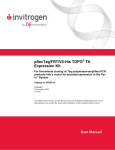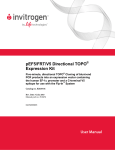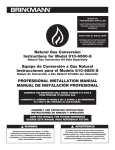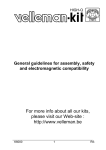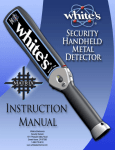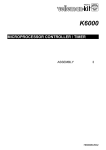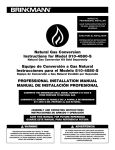Download 5/FRT - bioss - Centre for Biological Signalling Studies
Transcript
pcDNA™5/FRT Expression vector designed for use with the Flp-In™ System Catalog no. V6010-20 Version F 10 November 2010 25-0307 Corporate Headquarters Invitrogen Corporation 1600 Faraday Avenue Carlsbad, CA 92008 T: 1 760 603 7200 F: 1 760 602 6500 E: [email protected] For country-specific contact information visit our web site at www.invitrogen.com User Manual ii Table of Contents Kit Contents and Storage ................................................................................................................................ v Accessory Products......................................................................................................................................... vi Introduction ................................................................................................................................................................1 Overview ............................................................................................................................................................1 Methods.......................................................................................................................................................................3 Cloning into pcDNA™5/FRT...........................................................................................................................3 Transfection .......................................................................................................................................................5 Appendix.....................................................................................................................................................................7 Map of pcDNA™5/FRT Vector........................................................................................................................7 Features of pcDNA™5/FRT Vector.................................................................................................................8 pcDNA™5/FRT/CAT Vector ..........................................................................................................................9 Technical Support ...........................................................................................................................................10 Purchaser Notification....................................................................................................................................11 References ........................................................................................................................................................12 iii iv Kit Contents and Storage Shipping/Storage The pcDNA™5/FRT Vectors are shipped on wet ice. Upon receipt, store at –20°C. Kit Contents The following vectors are provided with pcDNA™5/FRT: Vector Quantity Contents pcDNA™5/FRT 20 μg 40 μl of 0.5 μg/μl pcDNA™5/FRT in 10 mM Tris–HCl, 1 mM EDTA, pH 8.0. pcDNA™5/FRT/CAT 20 μg 40 μl of 0.5 μg/μl pcDNA™5/ FRT/CAT in 10 mM Tris–HCl, 1 mM EDTA, pH 8.0. v Accessory Products Accessory Products Additional products available from Invitrogen are listed below. For more information, visit our website at www.invitrogen.com or contact Technical Support (page 10). Product Amount Catalog no. T7 Promoter Primer 2 μg, lyophilized N560–02 Zeocin™ 1g 5g 1g R250–01 R250–05 R220–05 20 μg, suspended as 40 μl of 0.5 μg/μl pFRT/lacZeo in 10 mM Tris–HCl, 1 mM EDTA, pH 8.0. 20 μg, suspended as 40 μl of 0.5 μg/μl pFRT/ lacZeo2 in 10 mM Tris–HCl, 1 mM EDTA, pH 8.0. 20 μg, suspended as 40 μl of 0.5 μg/μl pOG44 in 10 mM Tris–HCl, 1 mM EDTA, pH 8.0. 10 reactions V6015–20 20 reactions C4040–03 40 reactions C4040–06 10 reactions C4040–50 20 reactions C4040–52 Hygromycin pFRT/lacZeo pFRT/lacZeo2 pOG44 One Shot® Kit (TOP10 Chemically Competent Cells) ® One Shot Kit (TOP10 Electrocompetent Cells) Flp-In™ Expression Vectors Amount pcDNA™5/FRT/V5-His TOPO® TA Expression Kit pSecTag/FRT/V5-His TOPO® TA Expression Kit pEF5/FRT/V5 Directional TOPO® Expression Kit pEF5/FRT/V5-DEST Gateway™ Vector Pack 1 kit C4040–10 Catalog no. K6020–01 1 kit 1 kit 6 μg, supplied as 40 μl of 150ng/ul vector in 10 mM Tris–HCl, 1 mM EDTA, pH 8.0 K6025–01 K6035–01 V6020–20 For your convenience, Invitrogen has available several mammalian Flp-In™ host cell lines that stably express the lacZ-Zeocin™ fusion gene from pFRT/lacZeo or pFRT/lacZeo2. Each cell line contains a single integrated FRT site as confirmed by Southern blot analysis. The cell lines should be maintained in medium containing Zeocin™. For more information, visit our web site at www.invitrogen.com or contact Technical Support (page 10). Cell Line Flp-In™-293 Flp-In™-CV-1 Flp-In™-CHO Flp-In™-BHK Flp-In™-3T3 Flp-In™-Jurkat vi V6005–20 Additional Flp-In™ expression vectors are available from Invitrogen. For more information about the features of each vector, visit our web site at www.invitrogen.com or contact Technical Support (page 10). Product Flp-In™ Host Cell Lines V6022–20 Amount 3 × 106 cells, frozen 3 × 106 cells, frozen 3 × 106 cells, frozen 3 × 106 cells, frozen 3 × 106 cells, frozen 3 × 106 cells, frozen Catalog no. R750–07 R752–07 R758–07 R760–07 R761–07 R762–07 Introduction Overview Introduction pcDNA™5/FRT is a 5.1 kb expression vector designed for use with the Flp-In™ System (Catalog nos. K6010-01 and K6010-02) available from Invitrogen. When cotransfected with the pOG44 Flp recombinase expression plasmid into a Flp-In™ mammalian host cell line, the pcDNA™5/FRT vector containing the gene of interest is integrated in a Flp recombinase-dependent manner into the genome. The vector contains the following elements: • The human cytomegalovirus (CMV) immediate-early enhancer/promoter for high-level constitutive expression of the gene of interest in a wide range of mammalian cells (Andersson et al., 1989; Boshart et al., 1985; Nelson et al., 1987) • Multiple cloning site with 10 unique restriction sites to facilitate cloning the gene of interest • FLP Recombination Target (FRT) site for Flp recombinase-mediated integration of the vector into the Flp-In™ host cell line (see next page for more information) • Hygromycin resistance gene for selection of stable cell lines (Gritz & Davies, 1983) The control plasmid, pcDNA™5/FRT/CAT, is included for use as a positive control for transfection and expression in the Flp-In™ host cell line of choice. For more information about the Flp-In™ System, the pOG44 plasmid, and generation of the Flp-In™ host cell line, refer to the Flp-In™ System manual. The Flp-In™ System manual is supplied with the Flp-In™ Complete or Core Systems, but is also available for downloading from our Web site (www.invitrogen.com) or by contacting Technical Support (see page 10). A Note About pcDNA™5/FRT The pcDNA™5/FRT vector contains a single FRT site immediately upstream of the hygromycin resistance gene for Flp recombinase-mediated integration and selection of the pcDNA™5/FRT plasmid following cotransfection of the vector (with pOG44) into Flp-In™ mammalian host cells. The FRT site serves as both the recognition and cleavage site for the Flp recombinase and allows recombination to occur immediately adjacent to the hygromycin resistance gene. The Flp recombinase is expressed from the pOG44 plasmid. For more information about the FRT site and recombination, see the next page. For more information about pOG44, refer to the Flp-In™ System manual. Important The hygromycin resistance gene in pcDNA™5/FRT lacks a promoter and an ATG initiation codon; therefore, transfection of the pcDNA™5/FRT plasmid alone into mammalian host cells will not confer hygromycin resistance to the cells. The SV40 promoter and ATG initiation codon required for expression of the hygromycin resistance gene are integrated into the genome (in the Flp-In™ host cell line) and are only brought into the correct proximity and frame with the hygromycin resistance gene through Flp recombinase-mediated integration of pcDNA™5/FRT at the FRT site. For more information about the generation of the Flp-In™ host cell line and details of the Flp-In™ System, refer to the Flp-In™ System manual. Continued on next page 1 Overview, Continued Flp RecombinaseMediated DNA Recombination In the Flp-In™ System, integration of your pcDNA™5/FRT expression construct into the genome occurs via Flp recombinase-mediated intermolecular DNA recombination. The hallmarks of Flp-mediated recombination are listed below. • Recombination occurs between specific FRT sites (see below) on the interacting DNA molecules. • Recombination is conservative and requires no DNA synthesis; the FRT sites are preserved following recombination and there is minimal opportunity for introduction of mutations at the recombination site. • Strand exchange requires only the small 34 bp minimal FRT site (see below). For more information about the Flp recombinase and conservative site-specific recombination, refer to published reviews (Craig, 1988; Sauer, 1994). FRT Site The FRT site, originally isolated from Saccharomyces cerevisiae, serves as a binding site for Flp recombinase and has been well-characterized (Gronostajski & Sadowski, 1985; Jayaram, 1985; Sauer, 1994; Senecoff et al., 1985). The minimal FRT site consists of a 34 bp sequence containing two 13 bp imperfect inverted repeats separated by an 8 bp spacer that includes an Xba I restriction site (see figure below). An additional 13 bp repeat is found in most FRT sites, but is not required for cleavage (Andrews et al., 1985). While Flp recombinase binds to all three of the 13 bp repeats, strand cleavage actually occurs at the boundaries of the 8 bp spacer region (see figure below) (Andrews et al., 1985; Senecoff et al., 1985). Minimal FRT site CS GAAGTTCCTATTCCGAAGTTCCTATTCTCTAGAAAGTATAGGAAC TTC Xba I CS CS = cleavage site Experimental Outline The following table outlines the steps required to clone and express your gene of interest in pcDNA™5/FRT. Step Action 1 Consult the multiple cloning site diagrammed on page 4 to design your cloning strategy. 2 Ligate your insert into pcDNA™5/FRT and transform into E. coli. Select transformants on 50–100 μg/ml ampicillin. 3 Analyze your transformants for the presence of insert by restriction digestion. 4 Select a transformant with the correct restriction pattern and sequence to confirm that your gene is cloned in the correct orientation. 5 Cotransfect your pcDNA™5/FRT construct and pOG44 into the Flp-In™ host cell line using your own method of choice and select for hygromycin resistant clones (see the Flp-In™ System manual for more information). 6 Assay for expression of the gene of interest. 2 Methods Cloning into pcDNA™5/FRT Introduction A diagram is provided on the next page to help you clone your gene of interest into pcDNA™5/FRT. General considerations for cloning and transformation are listed below. General Molecular Biology Techniques For help with DNA ligations, E. coli transformations, restriction enzyme analysis, DNA sequencing, and DNA biochemistry, refer to Molecular Cloning: A Laboratory Manual (Sambrook et al., 1989) or Current Protocols in Molecular Biology (Ausubel et al., 1994). E. coli Strain Many E. coli strains are suitable for the propagation and maintenance of this vector. We recommend that you propagate vectors containing inserts in E. coli strains that are recombination deficient (recA) and endonuclease A deficient (endA). For your convenience, TOP10 is available as chemically competent or electrocompetent cells from Invitrogen (page vi). Transformation Method You may use any method of your choice for transformation. Chemical transformation is the most convenient method for many researchers. Electroporation is the most efficient and the method of choice for large plasmids. Maintenance of Plasmids To propagate and maintain the pcDNA™5/FRT and pcDNA™5/FRT/CAT vectors, we recommend using 10 ng of the vector to transform a recA, endA E. coli strain like TOP10, DH5α, JM109, or equivalent. Select transformants on LB agar plates containing 50–100 μg/ml ampicillin. Be sure to prepare a glycerol stock of each plasmid for long-term storage (see page 4). Cloning Considerations Your insert should contain a Kozak consensus sequence with an ATG initiation codon for proper initiation of translation (Kozak, 1987; Kozak, 1990; Kozak, 1991). An example of a Kozak consensus sequence is provided below. Other sequences are possible, but the G or A at position –3 and the G at position +4 (shown in bold) illustrates the most commonly occurring sequence with strong consensus. Replacing one of the two bases at these positions provides moderate consensus, while having neither results in weak consensus. The ATG initiation codon is shown underlined. (G/A)NNATGG Your insert must also contain a stop codon for proper termination of your gene. Continued on next page 3 Cloning into pcDNA™5/FRT, Continued Below is the multiple cloning site for pcDNA™5/FRT. Restriction sites are labeled to indicate the cleavage site. The multiple cloning site has been confirmed by sequencing and functional testing. The complete sequence of pcDNA™5/FRT is available for downloading from our web site at www.invitrogen.com or from Technical Support (page 10). For a map and a description of the features of pcDNA™5/FRT, refer to the Appendix, pages 7–8. Multiple Cloning Site of pcDNA™5/FRT CAAT CMV promoter 721 AAAATCAACG GGACTTTCCA AAATGTCGTA ACAACTCCGC CCCATTGACG CAAATGGGCG CMV forward priming site 781 TATA 3' end of CMV promoter putative transcriptional start GTAGGCGTGT ACGGTGGGAG GTCTATATAA GCAGAGCTCT CTGGCTAACT AGAGAACCCA T7 promoter/priming site 841 Pme I* 901 Afl II Hind III Asp718 I Bam H I Kpn I Bst X I* GTTTAAACTT AAGCTTGGTA CCGAGCTCGG ATCCACTAGT CCAGTGTGGT GGAATTCTGC Eco R V 961 Nhe I CTGCTTACTG GCTTATCGAA ATTAATACGA CTCACTATAG GGAGACCCAA GCTGGCTAGC Bst X I* Not I Xho I Apa I Pme I* AGATATCCAG CACAGTGGCG GCCGCTCGAG TCTAGAGGGC CCGTTTAAAC CCGCTGATCA BGH reverse priming site 1021 GCCTCGACTG TGCCTTCTAG TTGCCAGCCA TCTGTTGTTT GCCCCTCCCC CGTGCCTTCC *Note: there are two Pme I sites and two BstX I sites in the polylinker. MEND ION AT RECOM E. coli Transformation Preparing a Glycerol Stock 4 Transform your ligation mixtures into a competent recA, endA E. coli strain (e.g. TOP10, DH5 ) and select on LB agar plates containing 50 to 100 μg/ml ampicillin. Select 10–20 clones and analyze for the presence and orientation of your insert. We recommend that you sequence your construct to confirm that your gene is in the correct orientation for expression and contains an ATG initiation codon and a stop codon. To sequence your construct, we suggest using the T7 Promoter and BGH Reverse primer sequences. See page 4 for sequences and location of primer binding sites. For your convenience, Invitrogen offers the T7 Promoter Primer (page vi) as well as custom primer services. For more information on custom primer services, vist our web site at www.invitrogen.com or contact Technical Support (see page 10). Once you have identified the correct clone, purify the colony and make a glycerol stock for long-term storage. You should keep a DNA stock of your plasmid at –20°C. • Streak the original colony out on an LB plate containing 50 μg/ml ampicillin. Incubate the plate at 37°C overnight. • Isolate a single colony and inoculate into 1–2 ml of LB containing 50 μg/ml ampicillin. • Grow the culture to mid-log phase (OD600 = 0.5-0.7). • Mix 0.85 ml of culture with 0.15 ml of sterile glycerol and transfer to a cryovial. • Store at –80°C. Transfection Introduction Once you have cloned your gene of interest into pcDNA™5/FRT and have prepared clean plasmid preparations of your pcDNA™5/FRT construct and pOG44, you are ready to cotransfect the plasmids into your mammalian Flp-In™ host cell line to generate your stable Flp-In™ expression cell line. We recommend that you include the pcDNA™5/FRT/CAT positive control vector and a mock transfection (negative control) to evaluate your results. General information about transfection and selection is provided below. Specific guidelines and protocols for generation of the Flp-In™ expression cell line can be found in the Flp-In™ System manual. MEND ION AT RECOM For detailed information about pOG44 and generation of the Flp-In™ host cell line, refer to the Flp-In™ System manual. Important Several Flp-In™ host cell lines which stably express the lacZ-Zeocin™ fusion gene from pFRT/lacZeo or pFRT/lacZeo2 and which contain a single integrated FRT site are available from Invitrogen (see page vi for ordering information). If you wish to express your gene of interest in 293, CV-1, CHO, 3T3, BHK, or Jurkat cells, may want to use one of Invitrogen’s Flp-In™ cell lines as the host to establish your stable expression cell line. For more information, visit our web site www.invitrogen.com or contact Technical Support (see page 10). We have observed down-regulation of the viral CMV promoter and subsequent loss of gene expression when pcDNA™5/FRT-based expression constructs are introduced into 3T3 or BHK cells. This behavior is not observed with pEF5/FRTbased expression constructs. If you are generationg Flp-In™ expression cell lines using a 3T3 or BHK host cell line, we recommend that you clone your gene of interest into a pEF5/FRT-based expression plasmid (e.g. pEF5/FRT/V5-DTOPO® or pEF5/FRT/V5-DEST). For more information, visit our web site www.invitrogen.com or contact Technical Support (see page 10). Plasmid Preparation Plasmid DNA for transfection into eukaryotic cells must be very clean and free from phenol and sodium chloride. Contaminants will kill the cells, and salt will interfere with lipid complexing, decreasing transfection efficiency. We recommend isolating plasmid DNA using the S.N.A.P. ™ MiniPrep Kit (10–15 μg DNA, Catalog no. K1900-01), the S.N.A.P. ™ MidiPrep Kit (10–200 μg DNA, Catalog no. K1910-01), or CsCl gradient centrifugation. Positive Control pcDNA™5/FRT/CAT is provided as a positive control vector for mammalian cell transfection and expression (see page 9) and may be used to assay for recombinant protein expression levels in your Flp-In™ expression cell line. Cotransfection of the positive control vector and pOG44 into your Flp-In™ host cell line allows you to generate a stable cell line expressing chloramphenicol acetyl transferase (CAT) at the same genomic locus as your gene of interest. If you have several different Flp-In™ host cell lines, you may use the pcDNA™5/FRT/CAT control vector to compare protein expression levels between the various cell lines. Continued on next page 5 Transfection, Continued Assay for CAT Protein The CAT protein expressed from the pcDNA™5/FRT/CAT control plasmid is approximately 32 kDa in size. You may assay for CAT expression by ELISA assay, Western blot analysis, fluorometric assay, or radioactive assay (Ausubel et al., 1994; Neumann et al., 1987). For Western blot analysis, you may use CAT Antiserum available from Invitrogen for detection. Other commercial kits to assay for CAT protein are available. Hygromycin B The pcDNA™5/FRT vector contains the hygromycin resistance gene (Gritz & Davies, 1983) for selection of transfectants with the antibiotic, hygromycin B (Palmer et al., 1987). When added to cultured mammalian cells, hygromycin B acts as an aminocyclitol to inhibit protein synthesis. Hygromycin B liquid is supplied with the Flp-In™ Complete System and is also available separately from Invitrogen. For instructions to handle and store hygromycin B, refer to the Flp-In™ System manual. Determination of Hygromycin Sensitivity Before generating a stable cell line expressing your protein of interest (Flp-In™ expression cell line), we recommend that you generate a kill curve to determine the minimum concentration of hygromycin required to kill your untransfected Flp-In™ host cell line. Generally, concentrations between 10 and 400 μg/ml hygromycin are required for selection of most mammalian cell lines. General guidelines for performing a kill curve are provided in the Flp-In™ System manual. Generation of FlpIn™ Expression Cell Lines Refer to the Flp-In™ System manual for detailed guidelines and instructions to cotransfect your pcDNA™5/FRT construct and pOG44 into the Flp-In™ host cell line to generate stable Flp-In™ expression cell lines. 6 Appendix Map of pcDNA™5/FRT Vector The figure below summarizes the features of the pcDNA™5/FRT vector. Note that the hygromycin resistance gene lacks a promoter and its native ATG start codon. Transfection of the pcDNA™5/FRT plasmid alone into mammalian cells will not confer hygromycin resistance to the cells. The complete nucleotide sequence for pcDNA™5/FRT is available for downloading from our web site at www.invitrogen.com or by contacting Technical Support (page 10). T7 Nhe I Pme I Afl II Hind III Asp718 I Kpn I BamH I BstX I EcoR V BstX I Not I Xho I Apa I Pme I Map of pcDNA™5/FRT MV PC BGH pA T FR n p U C ori pA 40 SV Comments for pcDNA5/FRT 5070 nucleotides Hygro m y cin A m p i ci l li pcDNA5/FRT 5070 bp CMV promoter: bases 232-819 CMV forward priming site: bases 769-789 T7 promoter/priming site: bases 863-882 Multiple cloning site: bases 895-1010 BGH reverse priming site: bases 1022-1039 BGH polyadenylation signal: bases 1028-1252 FRT site: bases 1536-1583 Hygromycin resistance gene (no ATG): bases 1591-2611 SV40 early polyadenylation signal: bases 2743-2873 pUC origin: bases 3256-3929 (complementary strand) bla promoter: bases 4935-5033 (complementary strand) Ampicillin (bla) resistance gene: bases 4074-4934 (complementary strand) Continued on next page 7 Features of pcDNA™5/FRT Vector Features of pcDNA™5/FRT 8 pcDNA™5/FRT is a 5070 bp vector that expresses your gene of interest under the control of the human CMV promoter. The table below describes the relevant features of pcDNA™5/FRT. All features have been functionally tested. Feature Benefit Human cytomegalovirus (CMV) immediate early promoter Allows high-level expression of your gene of interest (Andersson et al., 1989; Boshart et al., 1985; Nelson et al., 1987). CMV Forward priming site Allows sequencing in the sense orientation. T7 promoter/priming site Allows in vitro transcription in the sense orientation and sequencing through the insert. Multiple cloning site Allows insertion of your gene of interest. pBGH Reverse priming site Allows sequencing of the non-coding strand Bovine growth hormone (BGH) polyadenylation signal Allows efficient transcription termination and polyadenylation of mRNA (Goodwin & Rottman, 1992). Flp Recombination Target (FRT) site Encodes a 34 bp (+14 bp of non-essential) sequence that serves as the binding and cleavage site for Flp recombinase (Gronostajski & Sadowski, 1985; Jayaram, 1985; Senecoff et al., 1985). Hygromycin resistance gene (no ATG) Allows selection of stable transfectants in mammalian cells (Gritz & Davies, 1983) when brought in frame with a promoter and an ATG initiation codon through Flp recombinase-mediated recombination via the FRT site. SV40 early polyadenylation signal Allows efficient transcription termination and polyadenylation of mRNA. pUC origin Allows high-copy number replication and growth in E. coli. bla promoter Allows expression of the ampicillin (bla) resistance gene. Ampicillin (bla) resistance gene (β-lactamase) Allows selection of transformants in E. coli. pcDNA™5/FRT/CAT Vector Map of pcDNA™5/FRT/ CAT The figure below summarizes the features of the pcDNA™5/FRT/CAT vector. The complete nucleotide sequence for pcDNA™5/FRT/CAT is available for downloading from our web site at www.invitrogen.com or from Technical Support (next page). T7 MV PC CAT Apa I Pme I pcDNA™5/FRT/CAT is a 5858 bp control vector containing the gene for chloramphenicol acetyl transferase (CAT). This vector was constructed by ligating a 0.7 kb Xho I-Apa I fragment containing the CAT gene into the Xho I-Apa I site of pcDNA™5/FRT. The CAT protein expressed from pcDNA™5/FRT/CAT is approximately 32 kDa in size. Nhe I Pme I Afl II Hind III Asp718 I Kpn I BamH I BstX I EcoR V BstX I Not I Xho I Description BGH pA T FR A m p i ci l li Hygrom yci n pcDNA5/FRT/CAT 5858 bp n pA CMV promoter: bases 232-819 CMV forward priming site: bases 769-789 p U C o ri T7 promoter/priming site: bases 863-882 Chloramphenicol acetyl transferase (CAT) gene: bases 1026-1685 BGH reverse priming site: bases 1810-1827 BGH polyadenylation signal: bases 1816-2040 FRT site: bases 2324-2371 Hygromycin resistance gene (no ATG): bases 2379-3399 SV40 early polyadenylation signal: bases 3531-3661 pUC origin: bases 4044-4717 (complementary strand) bla promoter: bases 5723-5821 (complementary strand) Ampicillin (bla) resistance gene: bases 4862-5722 (complementary strand) 40 SV Comments for pcDNA5/FRT/CAT 5858 nucleotides 9 Technical Support Web Resources Visit the Invitrogen web site at www.invitrogen.com for: • • • • Contact Us Technical resources, including manuals, vector maps and sequences, application notes, MSDSs, FAQs, formulations, citations, handbooks, etc. Complete technical support contact information. Access to the Invitrogen Online Catalog. Additional product information and special offers. For more information or technical assistance, call, write, fax, or email. Additional international offices are listed on our web site (www.invitrogen.com). Corporate Headquarters: Invitrogen Corporation 5791 Van Allen Way Carlsbad, CA 92008 USA Tel: 1 760 603 7200 Tel (Toll Free): 1 800 955 6288 Fax: 1 760 602 6500 E-mail: [email protected] Japanese Headquarters: Invitrogen Japan LOOP-X Bldg. 6F 3-9-15, Kaigan Minato-ku, Tokyo 108-0022 Tel: 81 3 5730 6509 Fax: 81 3 5730 6519 E-mail: [email protected] European Headquarters: Invitrogen Ltd Inchinnan Business Park 3 Fountain Drive Paisley PA4 9RF, UK Tel: +44 (0) 141 814 6100 Tech Fax: +44 (0) 141 814 6117 E-mail: [email protected] MSDS MSDSs (Material Safety Data Sheets) are available on our web site at www.invitrogen.com/msds. Certificate of Analysis The Certificate of Analysis (CofA) provides detailed quality control information for each product. The CofA is available on our website at www.invitrogen.com/cofa, and is searchable by product lot number, which is printed on each box. Limited Warranty Invitrogen is committed to providing our customers with high-quality goods and services. Our goal is to ensure that every customer is 100% satisfied with our products and our service. If you should have any questions or concerns about an Invitrogen product or service, contact our Technical Support Representatives. Invitrogen warrants that all of its products will perform according to specifications stated on the certificate of analysis. The company will replace, free of charge, any product that does not meet those specifications. This warranty limits Invitrogen Corporation’s liability only to the cost of the product. No warranty is granted for products beyond their listed expiration date. No warranty is applicable unless all product components are stored in accordance with instructions. Invitrogen reserves the right to select the method(s) used to analyze a product unless Invitrogen agrees to a specified method in writing prior to acceptance of the order. Invitrogen makes every effort to ensure the accuracy of its publications, but realizes that the occasional typographical or other error is inevitable. Therefore, Invitrogen makes no warranty of any kind regarding the contents of any publications or documentation. If you discover an error in any of our publications, please report it to our Technical Support Representatives. Invitrogen assumes no responsibility or liability for any special, incidental, indirect or consequential loss or damage whatsoever. The above limited warranty is sole and exclusive. No other warranty is made, whether expressed or implied, including any warranty of merchantability or fitness for a particular purpose. 10 Purchaser Notification Introduction Use of the Flp-In™ System and its components (“System”) is covered under a number of different licenses including those detailed below. Limited Label License No. 64: FlpIn™ System Life Technologies Corporation (“Life Technologies”) has a license to sell the Flp-In™ System and its components (“System”) to scientists for research purposes only, under the terms described below. Use of the System for any Commercial Purpose (as defined below) requires the user to obtain commercial licenses as detailed below. Before using the System, please read the terms and conditions set forth below. Your use of the System shall constitute acknowledgment and acceptance of these terms and conditions. If you do not wish to use the System pursuant to these terms and conditions, please contact Life Technologies’ Technical Services within 10 days to return the unused and unopened System for a full refund. Otherwise, please complete the User Registration Card and return it to Life Technologies. Life Technologies grants you a non-exclusive license to use the enclosed System for research purposes only. The System is being transferred to you in furtherance of, and reliance on, such license. You may not use the System, or the materials contained therein, for any Commercial Purpose without licenses for such purpose. Commercial Purpose includes: any use of the System or Expression Products in a Commercial Product; any use of the System or Expression Products in the manufacture of a Commercial Product; any sale of the System or Expression Products; any use of the System or Expression Products to facilitate or advance research or development of a Commercial Product; and any use of the System or Expression Products to facilitate or advance any research or development program the results of which will be applied to the development of a Commercial Product. “Expression Products” means products expressed with the System, or with the use of any vectors or host strains in the System. “Commercial Product” means any product intended for sale or commercial use. Access to the System must be limited solely to those officers, employees and students of your entity who need access to perform the aforementioned research. Each such officer, employee and student must be informed of these terms and conditions and agree, in writing, to be bound by same. You may not distribute the System or the vectors or host strains contained in it to others. You may not transfer modified, altered, or original material from the System to a third party without written notification to, and written approval from Life Technologies. You may not assign, sub-license, rent, lease or otherwise transfer any of the rights or obligations set forth herein, except as expressly permitted by Life Technologies. This product is licensed under U.S. Patent Nos. 5,654,182 and 5,677,177 and is for research purposes only. Inquiries about licensing for commercial or other uses should be directed to: The Salk Institute for Biological Studies, 10010 North Torrey Pines Road, La Jolla, CA 92037, Attn.: Department of Intellectual Property and Technology Transfer. Phone: 858-453-4100 ext 1703; Fax: 858-450-0509; Email: [email protected] . 11 References Andersson, S., Davis, D. L., Dahlbäck, H., Jörnvall, H., and Russell, D. W. (1989) Cloning, Structure, and Expression of the Mitochondrial Cytochrome P-450 Sterol 26-Hydroxylase, a Bile Acid Biosynthetic Enzyme. J. Biol. Chem. 264, 8222-8229 Andrews, B. J., Proteau, G. A., Beatty, L. G., and Sadowski, P. D. (1985) The FLP Recombinase of the 2 Micron Circle DNA of Yeast: Interaction with its Target Sequences. Cell 40, 795-803 Ausubel, F. M., Brent, R., Kingston, R. E., Moore, D. D., Seidman, J. G., Smith, J. A., and Struhl, K. (1994) Current Protocols in Molecular Biology, Greene Publishing Associates and Wiley-Interscience, New York Boshart, M., Weber, F., Jahn, G., Dorsch-Häsler, K., Fleckenstein, B., and Schaffner, W. (1985) A Very Strong Enhancer is Located Upstream of an Immediate Early Gene of Human Cytomegalovirus. Cell 41, 521-530 Craig, N. L. (1988) The Mechanism of Conservative Site-Specific Recombination. Ann. Rev. Genet. 22, 77105 Goodwin, E. C., and Rottman, F. M. (1992) The 3´-Flanking Sequence of the Bovine Growth Hormone Gene Contains Novel Elements Required for Efficient and Accurate Polyadenylation. J. Biol. Chem. 267, 16330-16334 Gritz, L., and Davies, J. (1983) Plasmid-Encoded Hygromycin-B Resistance: The Sequence of Hygromycin-B-Phosphotransferase Gene and its Expression in E. coli and S. Cerevisiae. Gene 25, 179-188 Gronostajski, R. M., and Sadowski, P. D. (1985) Determination of DNA Sequences Essential for FLPmediated Recombination by a Novel Method. J. Biol. Chem. 260, 12320-12327 Jayaram, M. (1985) Two-micrometer Circle Site-specific Recombination: The Minimal Substrate and the Possible Role of Flanking Sequences. Proc. Natl. Acad. Sci. USA 82, 5875-5879 Kozak, M. (1987) An Analysis of 5´-Noncoding Sequences from 699 Vertebrate Messenger RNAs. Nucleic Acids Res. 15, 8125-8148 Kozak, M. (1990) Downstream Secondary Structure Facilitates Recognition of Initiator Codons by Eukaryotic Ribosomes. Proc. Natl. Acad. Sci. USA 87, 8301-8305 Kozak, M. (1991) An Analysis of Vertebrate mRNA Sequences: Intimations of Translational Control. J. Cell Biology 115, 887-903 Nelson, J. A., Reynolds-Kohler, C., and Smith, B. A. (1987) Negative and Positive Regulation by a Short Segment in the 5´-Flanking Region of the Human Cytomegalovirus Major Immediate-Early Gene. Molec. Cell. Biol. 7, 4125-4129 Neumann, J. R., Morency, C. A., and Russian, K. O. (1987) A Novel Rapid Assay for Chloramphenicol Acetyltransferase Gene Expression. BioTechniques 5, 444-447 Palmer, T. D., Hock, R. A., Osborne, W. R. A., and Miller, A. D. (1987) Efficient Retrovirus-Mediated Transfer and Expression of a Human Adenosine Deaminase Gene in Diploid Skin Fibroblasts from an Adenosine-Deficient Human. Proc. Natl. Acad. Sci. U.S.A. 84, 1055-1059 Sambrook, J., Fritsch, E. F., and Maniatis, T. (1989) Molecular Cloning: A Laboratory Manual, Second Ed., Cold Spring Harbor Laboratory Press, Plainview, New York Sauer, B. (1994) Site-Specific Recombination: Developments and Applications. Curr. Opin. Biotechnol. 5, 521-527 Senecoff, J. F., Bruckner, R. C., and Cox, M. M. (1985) The FLP Recombinase of the Yeast 2-micron Plasmid: Characterization of its Recombination Site. Proc. Natl. Acad. Sci. USA 82, 7270-7274 ©1999-2008, 2010 Invitrogen Corporation. All rights reserved. For research use only. Not intended for any animal or human therapeutic or diagnostic use. 12 13 Corporate Headquarters Invitrogen Corporation 5791 Van Allen Way Carlsbad, CA 92008 T: 1 760 603 7200 F: 1 760 602 6500 E: [email protected] For country-specific contact information, visit our web site at www.invitrogen.com User Manual





















